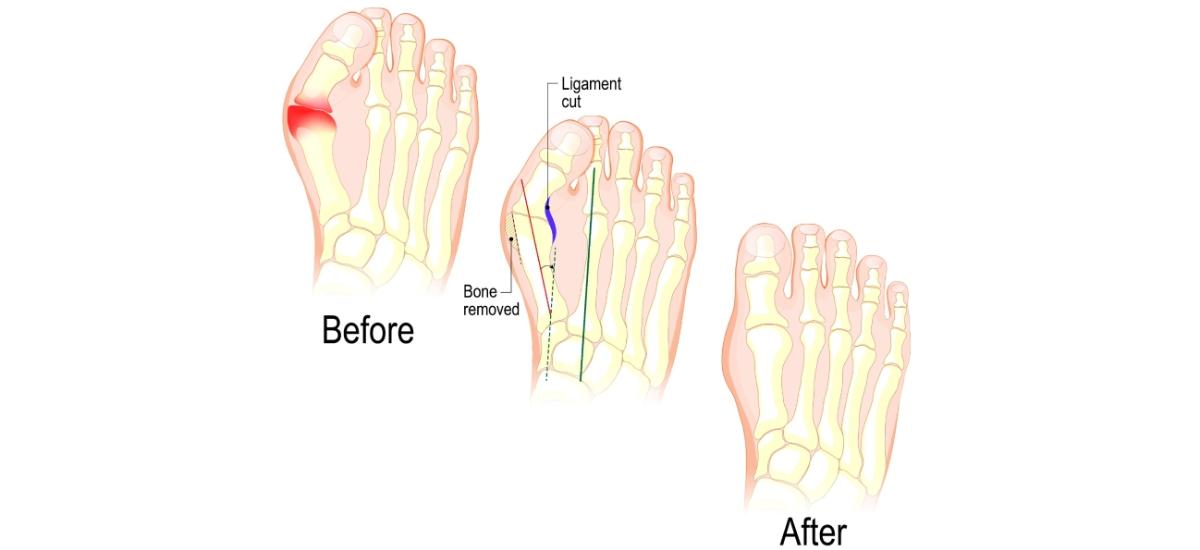
One of the most common problems, valgus deformity of the first toe, is the formation of a bunion, which can severely limit movement and quality of life.
What is a bunion and why is a bunionectomy important?
A bunion is a knobby bony protrusion that forms in the joint at the base of the big toe of the foot. It is often accompanied by inflammation and pain. Many factors contribute to the development of such pathology.
- Genetic predisposition;
- uncomfortable, ill-fitting shoes;
- abnormal development of foot structures;
- trauma and inflammatory diseases of the foot and joints;
- acquired deformity due to wearing high-heeled shoes.
Over time, a protruding bone can progress and lead to the development of complications in the form of arthritis. For many patients, bunionectomy surgery is therefore a necessary step to regaining an active life without pain and discomfort.
Bunionectomy is a surgical procedure. Its main goal is to restore the normal anatomy of the foot and prevent further progression of the disease.
Basic principles of bunionectomy
- Deformity correction;
- elimination of inflammation and pain;
- preservation of foot function;
- achieving aesthetic results.
When Is Bunionectomy Recommended?
The question of the need for bunionectomy of the foot arises when considering the symptoms and the extent of their impact on quality of life. Despite the fact that in certain cases of such pathology can be managed with conservative methods, there are situations when surgical intervention becomes the most effective and appropriate solution. This is due to the vivid manifestation of pathologic symptoms.
- Discomfort, constant or intense pain;
- limited movement of the big toe;
- frequent inflammatory or infectious processes in the bunion area;
- progressive worsening (increase in the size of the ossicles, worsening of symptoms).
What is the difference between the need for conservative treatment and surgical intervention?
- Conservative treatment may include wearing appropriate footwear, the use of orthotic insoles, physical therapy and the use of painkillers to manage pain and inflammation. However, if symptoms do not improve or continue to progress, surgery may be the only way to achieve long-term relief and restoration of foot function.
- Surgical intervention the opportunity to correct the anatomical defects that underlie the development of the pathology and can prevent the problem from recurring in the future.
If you have bunions and are experiencing discomfort, contact the experts at Illinois Foot & Ankle Clinic for a consultation and evaluation of the need for surgical intervention.
Preparation for Surgery
Effective preparation for surgery is an important step toward a successful recovery. It includes:
Consultation with a surgeon
Diagnostic tests and examinations:
- blood tests;
- coagulogram;
- electrocardiogram (EKG);
- X-rays of the foot.
Lifestyle preparation
Changes in diet, stopping alcohol and nicotine use, and temporarily stopping certain medications such as aspirin or drugs that affect blood clotting. Your doctor will discuss any necessary changes with you in detail.
The Bunionectomy Procedure
There are several different surgical techniques. Their choice depends on the individual characteristics of the patient and the degree of foot deformity.
- Lapiplasty: one of the most common surgical techniques. During the procedure, the surgeon makes an incision on the inside of the foot to gain access to the joint of the big toe. He or she corrects the joint deformity and removes excess bone tissue. The joint is then stabilized with special implants or fixation.
- Lapidus bunionectomy: this technique is used in cases of severe bone protrusion or in the presence of additional deformities of the foot. In the lapidus procedure, the surgeon makes an incision at the base of the first metatarsal bone and performs correction of the joint deformity. He fixes the joint with implants or special osteosynthetic fixation to prevent recurrence.
- Minimally invasive bunionectomy: modern technique allows the operation to be performed with minimal damage to the surrounding tissue. With it, the surgeon uses small incisions and special instruments to remove the bunion. Minimally invasive surgery is usually associated with a faster recovery and lower risk of complications.
The cost of bunionectomy can vary significantly depending on the method of surgery used and the severity of the disease.
Recovery and Aftercare
After a bunionectomy, it is important to follow your doctor's recommendations to ensure a full recovery. This includes:
- Wound care: changing of the dressing and use of antimicrobial agents.
- Activity restriction: in the first few weeks after surgery, you will need to limit physical activity and avoid overloading the foot.
- Physical therapy and exercises to restore mobility to the foot and strengthen the muscles. This may include stretching and balancing exercises.
- Support and monitoring: Your doctor will monitor your recovery and conduct regular check-ups.
Recovery time varies depending on the complexity of the surgery and the individual characteristics of the patient. On average, it is possible to return to normal activity 6–12 weeks after surgery.
Benefits of Surgery at Illinois Foot & Ankle Clinic
When choosing where to have surgery, it is important to consider the experience of the specialists, quality of care, and access to advanced technology. You can have a bunionectomy near you, Dr. Alex Yanovskiy at Illinois Foot & Ankle Clinic provides top-notch surgical care in Des Plaines, providing patients with a number of benefits, including:
- Individual approach to each patient.
- A wide range of modern technologies and techniques.
- Minimally invasive treatment approaches.
- Comprehensive medical care.
Experience the freedom of an active life, free from the constraints of pain or discomfort, by choosing Illinois Foot & Ankle Clinic for your bunionectomy. Schedule a consultation today and take the first step towards lasting relief and improved mobility. Your journey to pain-free living starts here.